See the full PicLit at PicLits.com
Sunday, 21 December 2008
PicLits
See the full PicLit at PicLits.com
Monday, 8 December 2008
Commemorate 20 years of Chembakolli with an interactive online march and new story book
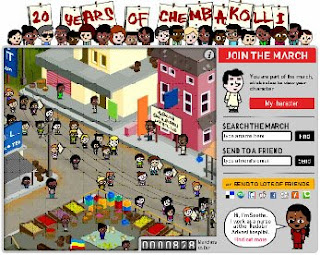
Christopher Rushbrook Schools Marketing and Promotions Manager ActionAid
For
26 September 2008: Chembakolli, a village in southern
To celebrate this anniversary, ActionAid is launching an online march, enabling teachers and pupils to create their own character and personalised placard before joining the virtual march.
Starting in Gudalur, the virtual route follows the footsteps of the real march, twenty years ago. In the town, the marchers can click on local landmarks, including market stalls, the hospital and school, and meet real life people and read their stories. As more people join the march, the route will extend into Chembakolli where visitors can learn about life in the village by clicking on parts of the village, local people, and an elephant.
As part of the celebrations, ActionAid has also produced The Chembakolli story, a beautifully narrated audio CD accompanied by a story/activity book and poster. The CD covers the events of the past 20 years in six parts, each with descriptive sound and music clips recorded in the village. It is ideal for classroom listening and interpretive learning and is available for £20 (inc p&p).
To take part go to the Adivasi Lands Right March websiteWednesday, 3 December 2008
Tom Barrett's Blog - Using Google Earth to plot the journey of James and the Giant Peach
Tom has been doing some amazing work with his class on using Google Earth to plot the story of James and the Giant Peach. Start with his final page of the story and then choose the links to work back.
He has also been using Vocaro to record children's voices - which were then embedded into Google. Please read his blog to find out more.
Friday, 28 November 2008
Monday, 13 October 2008
The opening of the new Castleford Bridge - 4th July 2008
 |
| Opening of Castleford Bridge - 4th July 2008 |
Sunday, 12 October 2008
Support for the Primary Geography Quality Mark
An overview of the PGQM can be found on the GA PGQM website. Additional support for teachers who are interested in primary geography is available on the PGQM password protected website - access to this website is available to all members of the GA and details of how to request a password are available from the main GA PGQM Site.
My most recent PowerPoint was produced for a PGQM teachers workshop and was aimed at encouraging teachers to think much more creatively about the kind of geography that they teach.
Public Profiler World Names Website
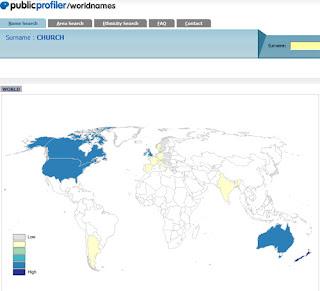
Public Profiler World Names: this website lets you discover how common your surname is around the world. Type in your surname and the website generates a world map to show how popular your name is. It's also possible to zoom in and have a look at regional variations. Keep an eye on the actual `numbers' as the colour coding on the maps can mask a great variety in the actual numbers. A fascinating website and easy to see how it could lead to some fascinating geography and history for that matter. For example, why is there a higher frequency of people per million with the name Church in New Zealand than in the UK? Why are there Hamblen's in the USA and not in Canada?
This site is worth a look.
Thursday, 4 September 2008
Geograph: an image for every square kilometre in the UK

We’ve had a really good August at home this year walking local footpaths and finding places that we’ve never been to before, all within a 5 mile radius of home. The motivator for all of this activity has been the Geograph website.
If you are not familiar with the site, then the aim of Geograph is to collect photographs for every square kilometre within the UK. 88% of England, Scotland & Wales now have at least one photo per kilometre square and 22% of Ireland has been covered.
This is a really useful website if you need images of the UK, first because all images are shared under the Creative Commons License (this means that although the photographer owns the copyright they have agreed to other people using their images). Second because the images are a reasonable size (640 pixels wide) they are very useful for projecting on an interactive whiteboard. So forget those tiddly little snippets that you find through searching Google Images – most of which are covered by copyright – and nearly all of which are useless for projecting and start exploring Geograph.
So log-on to their website: www.geograph.org.uk
Choose a place – it’s not very good at recognising postcodes – so either the place name or a four figure Grid reference work best.
If you want to see where I’ve been walking, then you could start in the west on the Moorland above Langsett ( SE1800 in the search box or http://www.geograph.org.uk/gridref/SE1800 should take you directly there) and try working your way east towards the M1 motorway.
Monday, 4 August 2008
Creating a `My Walks' Map using Google Maps
Google `My Maps' uses the Google Maps website as opposed to the downloadable `Google Earth' - so there is no need to download anything to your computer.
It is easy to add images into the hotspots that you create as long as your images link to a photo that is stored online, for example on the Geograph website or perhaps on Flickr or Picasa.
Follow the instructions on the presentation to learn how to create your own illustrated maps.
Additional guidance is available from Google
Friday, 27 June 2008
Action Plan for Geography: teachers create geography resources for other teachers

There have been some fantastic resources shared by teachers who have attended the final day of the APG (Action Plan for Geography) Curriculum Making Conferences.
Rosemary Slack of Middleton Primary School in Leeds has shared some great stuff on `Recycling'. This was linked to a visit that she made to Skelton Grange Environment Centre in Leeds.
As their contribution to Citizenship two teachers, one from Bamford Primary School, Rochdale and the other from North Reddish Primary School, Stockport chose to focus on the `Who do we think we are project' that is being supported by the Historical Association and the Royal Geographical Society (RGS with IBG). You can find out more about this project by clicking on the link below:
Who do we think we are?
We also had some really interesting curriculum resources developed around the software mapping programme `Local Studies' and Rosemary Crocker from St Paul's Primary School has provided an amazing account of her work in the local area while several teachers chose to base their work around a village in India.
We are hoping to showcase the more developed projects on the Geography Teaching Today website which is the official website for the APG (Action Plan for Geography) - you will find these on the Teaching Ideas Page (this is an open website) where we already have a number of resources available for teachers of geography to view and download.
Meanwhile anyone who is a member of the Geographical Association can request access to our password protected website for Primary Geography. You will need to e-mail Julie Beattie to access this site. When she has checked out your membership details she will provide you with a user name and password. jbeattie@geography.org.uk
There's been lots going on
It's over a month since I last added a post to this blog and there has been so much happening that I've only just got round to completing this new post. It has been my grandsons second birthday which took place in his garden - complete with bouncy castle and a bounty of other toddlers (plus some quite grown up children). I had a few days in Spain around my birthday - visiting friends near Almunecar = and since then I've been incredibly busy at work on the Action Plan for Geography.
For work, I've been to Newcastle, Manchester, Birmingham and Cambridge for the last day of the APG `Curriculum Making Conferences' and have spent quite a few days putting some excellent teacher resources onto the Geographical Association password protected website. I'll add a new post about this work. I've also been editing additional resources for the Young Geographers Project - again I'll add a separate post for this. Keep looking - more to follow.
Monday, 5 May 2008
The Ordnance Survey & Becta schools map pilot
The introduction on the E-map site reads:
`The MapPilot enables a range of Ordnance Survey digital mapping to be accessed free by pilot schools and educational mapping suppliers for a trial period. MapPilot is run by Becta, in conjunction with The Advisory Unit: Computers in Education and eMapSite with funding from DfES and support from Ordnance Survey.'
I'm currently registered with the map pilot in conjunction with Methodist J & I and I've finally got around to downloading some maps from the site and using them in conjunction with the software programme `Local Studies'.
The map I chose to use was the `Streetview' map of Wakefield, which was unknown to me before I became involved in the project. It is simple and clear and allows some additional information to be added to the map (via a simple GIS such as Local Studies) without appearing too cluttered and illegible.We have used a `Streetview' map of the south side of Wakefield city to record our `Top Ten Places in Wakefield'. We also used images downloaded from the Geograph website to populate the hotspots.
`The Geograph British Isles project aims to collect geographically representative photographs and information for every square kilometre of Great Britain and Ireland.'
This is the first opportunity that the majority of the children in the class have had to link data to locations on a Wakefield map (as opposed to maps of the school grounds) and I have been delighted to find out how well many of the children can do this.
The PowerPoint embedded below illustrates work that we undertook during week 6 & 7 of my visits to the school. The children are now fairly accomplished users of Local Studies and the staff in the school like the programme.
(Though I'm still not convinced that I would recommend the software to schools in future as my feeling is that the software company is not keeping it sufficiently updated and compatible with modern school networks.)
Sunday, 4 May 2008
Using `Local Studies' the story continues ...
I was able to show them a few examples of work about the `local area' that had been undertaken in other schools. They were particularly interested in hearing that Year 1 at Shelley Primary School near Huddersfield had been using `Quikmaps' to record what happened in their village and additionally pleased to know that their own example had been the inspiration for other schools.
The PowerPoint in this post shows the work we started on the 16th April (after a gap of 4 months). I was really interested in the different styles of maps that the children had drawn and this PowerPoint is more of an exploration of what the children did, rather than `how to do' Local Studies.
Saturday, 3 May 2008
Do you use online mapping to locate places? If so which ones?
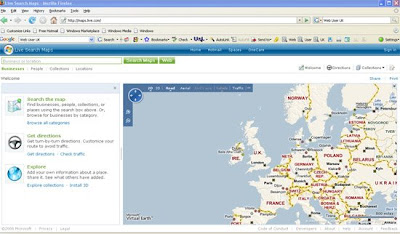 The current round of voting has now closed. Nineteen people have registered their vote so far – which is pleasing because I recognise that this is a relatively unknown blog.
The current round of voting has now closed. Nineteen people have registered their vote so far – which is pleasing because I recognise that this is a relatively unknown blog. As might be anticipated Google Maps and Google Earth have achieved the highest scores (though only just) and Multi-Map is perhaps beginning to lose out. This overall score reflects my own current use of online mapping as I much prefer Google Maps to the re-vamped version of Multi-map.
One programme that is well worth a look is the Microsoft website, variously known as Live Local, Maps Live etc. This has not scored as well as Google maps yet for some parts of the country the satellite views are far more detailed than on Google Maps.
The current edition of Web User Magazine 24 April – 7 May 2008, Issue 186 (which I think is excellent), devotes 2 pages to getting the most from `Live Search Maps’, pp. 62-63
Saturday, 12 April 2008
The Young Geographers Project has been launched on the GA website
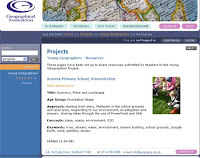 The first of our our Young Geographers project resources, written by Jane Mulligan of Austrey Primary School, Warwickshire has been added to the Geographical Association website. Click on the page image to be taken to the website.
The first of our our Young Geographers project resources, written by Jane Mulligan of Austrey Primary School, Warwickshire has been added to the Geographical Association website. Click on the page image to be taken to the website.This new project for primary schools focuses on four key areas: engaging in practical curriculum making, 'living geography', Learning Outside the Classroom and Education for Sustainable Development.
An earlier reference to the Sheffield Project can be found in a post I made on this site in January.
Further information about the work of the Canterbury Project can be found on the blog of my colleague Paula Owens.
Wednesday, 2 April 2008
Geographical Association Conference
I've just returned from the annual Geographical Association Conference which was held in Guildford this year. It was attended by over 700 people and the overwhelming feeling is that the conference was a real success. Kate Russell and I ran a workshop on behalf of the ICT working group with thirty + enthusiastic geographers attending. Our message to the group was that we need to extend the use of online mapping in the primary classroom. I was able to provide an overview of the work I've been doing with the Y5 class on using Local Studies and Quikmaps. see the embedded PowerPoint below:
Find out more about the conference presentations at:
http://www.geography.org.uk/events/annualconference
See below for a quick guide to creating a personalised map using Quikmaps
Saturday, 8 March 2008
Please Keep Voting + some new websites
I've been exploring two websites that are totally new to me this morning and one that I've seen before but haven't used much.
The first one is a mash up of Google Maps and Flickr called Flickrvision
This shows the latest images posted to the Flickr website over a Google Map. Choose the 3D view and you see a view of the Earth from space. This is fantastic because it shows which parts of the globe have night and which day. It's quite fascinating to see images pop up from different parts of the world.
The second is called WalkJogRun
and enables you to trace a route on a Google Map. It measures the distance, records your route and tell you how long it will take you to complete the journey depend on your speed of travel. Great for walkers and runners but also very useful for route planning activities in the classroom.
The third programme is called Flash Earth and allows you to view your chosen location via a number of different online mapping programmes. Add a comment after this post to let me know if you have found any of these websites useful.
Saturday, 16 February 2008
Curriculum Making from Cambridge: using Local Studies
Sue Kelly, a teacher from King’s Lynn, shares how she embarked on the process of learning to use the software programme `Local Studies' through this PowerPoint.
Sue attended the second round of the Geographical Association Curriculum Making Conferences in Cambridge. (These CPD events were offered as part of the Action Plan for Geography.) The Primary ICT sessions were developed around the use of Local Studies Software (Soft Teach Education) andteachers who attended the first day of the course needed to go onto develop their own understanding of the programme in order to use it with children they would be teaching.
If anyone else has developed resources using Local Studies software that they would be willing to share - please e-mail me at wnorth@geography.org.uk.
Tuesday, 29 January 2008
Geography & Food: starting from stories
Monday, 28 January 2008
Workshop: Geography & Food
The PowerPoint that I used to summarise the focus of my planning is shown below:
There are a number of projects linked to food and farming on the Oxfam Education website, including Making a Meal of It. Activity 5: Unpacking the supermarket bag is referred to on slide 6 of the presentation.
There are lots of links to online materials for teaching about food. Some are strongly geography focused while others focus more clearly on other curriculum areas, e.g. science. I'll be sharing some of these links on this blog over the next few weeks. If you have successfully taught geography through a food topic why not contribute your ideas.
Reflections on a Primary Cross-Curricular & Creativity Conference
On Friday 25th January I took part in a conference for a pyramid of Wakefield schools. What follows are a few of my thoughts linked to the keynote presentation.
The first thing that strikes me is the influential role of some of the independent educational consultancies in shaping the direction that primary schools take when reviewing their curriculum. In this case our conference was led by a well regarded keynote speaker from a prominent commercial education consultancy.
[I want to return to two of these areas, i.e. the ones that relate to assessment in geography and to Global Warming in a later entry.]
So, do the solutions to the primary curriculum lie with the published advice and guidance that commercial educational organisations provide or do the solutions lie with teachers in the classroom who know their pupils and want to provide a curriculum that starts with the child and takes into account the needs of the child and the community in which the child grows up?
Wednesday, 23 January 2008
Books & websites for developing an understanding of Global Citizenship and Education for Sustainable Development
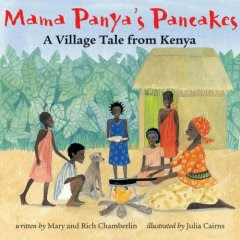 It was great to meet so many enthusiastic teachers at yesterday's Quality Geography Conference in London.
It was great to meet so many enthusiastic teachers at yesterday's Quality Geography Conference in London.One of the things we discussed was using books as starting points for learning in geography and I offered to make a book and website list available through this site. Click on the link below (green text) to access a WORD document which lists a selection of books and websites on the theme:
Global Citizenship and Education for Sustainable Development
Sunday, 20 January 2008
Young Geographers - access to Word documents

The Word documents that were shared on the first day of the Young Geographers Project in Sheffield can be accessed by clicking on the highlighted link.
See below for access to PowerPoint presentations from the day.
Saturday, 19 January 2008
Planning with `big ideas'
Currently KS3 are being asked to focus their planning for geography around key concepts. Paula Owens (my job share partner) and I have been thinking about whether a similar approach could be useful in the primary school. We believe that the use of `concepts' as a planning tool might help ensure that geography does not disappear from the curriculum if schools move towards cross-curricular approaches to learning.
The second half of the presentation shows `Living Geography' in action in school.
The last three slides provide guidance for project members on the format for writing up their materials to be included on the GA project page - Young Geographers
Primary Young Geographers Project
Additional information will be shared via the main GA project page website:
We had a very succesful first day yesterday which helped to get the project off to a very positive start. Through the project we are empasising four main elements:
· Engaging in practical 'curriculum making'
· Capturing the sense of motivating 'living geography'
· Learning Outside the Classroom
· Education for Sustainable Development
My introductory presentation was designed to promote reflection on what we might mean when we talk about `Living Geography' and what kinds of activities teachers are using to develop this approach in the primary classroom.View `Living Geography' presentation.
The notes that follow may help you to make sense of some of the thinking that went into the presentation:
- Who am I? Why focusing on `identity’ is a valuable place to start when thinking geographically.
· The link between place and identity, i.e where we grow up is a key factor in shaping our identity
· The importance of engaging young people with their own place and supporting them to explore their feelings about the place – Quikmaps example,
· Involving young people in `changing places’ – the importance of feeling that you can make a difference to your community, learning how change happens, what’s involved, making change happen (making learning real - not just another `school' activity)
· The importance of geographical imagination to the way we think about `place’ – location, first hand-experience, the way the world is represented to us and our emotional response to places are all important factors in shaping our geographical imaginations. Actual journey’s (fieldwork) and virtual journeys (role-play, drama, imaginative engagement with photographs) are valuable classroom activities that both inform and extend our geographical imagination.
· Discussions with others can help us to re-think the way that the world has been represented to us - `What image comes into your head when you are asked to think about
- Our concluding slides ask you to think about `school geography’ and experience of geography in our everyday lives – which kind of experience do we want for the children we teach?





